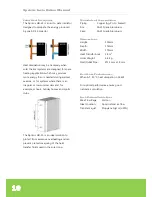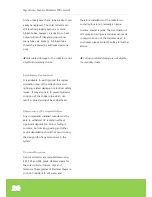
23
During stagnation, the collector, unable to
actively dump heat, will continue to rise in
temperature until the heat loss from the
collector and piping equals the heat being
absorbed. In strong sunlight with high
ambient temperatures, the collector can
reach peak stagnation temperatures from
160-220
°
C. Hence, components that may be
exposed to these high temperatures such as
valves, plumbing or insulation should be
suitably rated.
Pressure Loss with Height
Even though a system might be a closed
loop and pressurized, there is always some
pressure loss caused by height. This is
extremely important to understand when
deciding the system pressure. The loss of
pressure is about 0.1 bar per vertical meter.
A low system pressure at the collector can
result in bubbles (vapour) forming within the
heat transfer fluid due to a lowered fluid
boiling temperature. These bubbles can
collect in high points in the solar loop
piping, especially within the collector itself,
and cause air locks in the system that will
result in stagnation, because the pump does
not have the power to push fluid through
vapour pressure.
Size System to Avoid Overheating
The system should be sized so that
overheating of the tank is difficult to achieve
in a single day, even during hot, sunny
periods.
For properly sized open and closed loop
systems with suitable heat transfer fluid, it is
acceptable for the system design to allow
the solar collector to stagnate (i.e. stop the
pump) from time-to-time to prevent
overheating of the storage tank above the
maximum cylinder set temperature. An
expansion tank must be properly sized and
installed to accept the increase in fluid
volume due to thermal expansion and
potential steam formation, in order to
minimise or prevent release of fluid from the
pressure relief valve.
If the system is over-sized, so that stagnation
occurs often during summer months, the
system must be able to stagnate repeatedly
without damage or heat transfer fluid
degradation. Using stagnation as a daily
means of dealing with an oversized system is
NOT recommended.
✖
Gradual loss of vacuum in evacuated
tubes over time during normal use is not
eligible for warranty claims.
Heat Dissipation
For systems designed for space heating that
produce excessive summer heat output a
heat dissipation loop should be installed.
CoolSky offer an Apricus kit specially
designed for this purpose, the HD-25 Heat
Dissipater. This unit can be installed above
the pump station on the Flow Line from the
















































